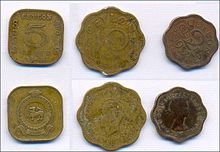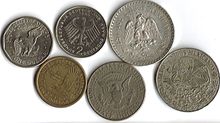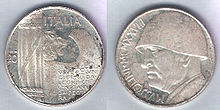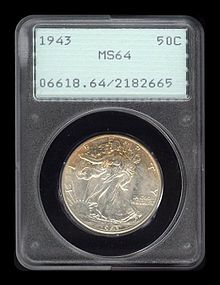- Coin collecting
-

Numismatics Terminology
 Portal
PortalCurrency Circulating currencies
Community currenciesAncient currencies -
Greek, Roman
ByzantineModern currencies
-
Africa, The Americas,
Europe, Asia, Oceania
Production -
Mint, Designers
Exonumia Coin collecting is the collecting or trading of coins or other forms of minted legal tender.
Coins of interest to collectors often include those that circulated for only a brief time, coins with mint errors and especially beautiful or historically significant pieces. Coin collecting can be differentiated from numismatics in that the latter is the systematic study of currency. Though closely related, the two disciplines are not necessarily the same. A numismatist may or may not be a coin collector and vice versa.
Contents
History
People have hoarded coins for their bullion value for as long as coins have been minted.[1] However, the collection of coins for their artistic value was a later development. Evidence from the archaeological and historical record of Ancient Rome and medieval Mesopotamia[2] indicates that coins were collected and catalogued by scholars and state treasuries. It also seems probable that individual citizens collected old, exotic or commemorative coins as an affordable, portable form of art.[3] According to Suetonius in his De vita Caesarum (The Lives of the Twelve Caesars), written in the first century CE, the emperor Augustus sometimes presented old and exotic coins to friends and courtiers during festivals and other special occasions.[4]
Contemporary coin collecting and appreciation began around the fourteenth century. During the Renaissance coin collecting became a fad among some members of the privileged classes. The Italian scholar and poet Petrarch is credited with being the pursuit's first and most famous aficionado. Following his lead, many European kings, princes, and other nobility kept collections of ancient coins. Some of notable collectors were Pope Boniface VIII, Emperor Maximilian[disambiguation needed
 ] of the Holy Roman Empire, Louis XIV of France, Ferdinand I, Henry IV of France and Elector Joachim II of Brandenburg, who started the Berlin Coin Cabinet (German: Münzkabinett Berlin). Perhaps because only the very wealthy could afford the pursuit, in Renaissance times coin collecting became known as the "Hobby of Kings."[5][6][7]
] of the Holy Roman Empire, Louis XIV of France, Ferdinand I, Henry IV of France and Elector Joachim II of Brandenburg, who started the Berlin Coin Cabinet (German: Münzkabinett Berlin). Perhaps because only the very wealthy could afford the pursuit, in Renaissance times coin collecting became known as the "Hobby of Kings."[5][6][7]During the 17th and 18th centuries coin collecting remained a pursuit of the well-to-do. But rational, Enlightenment thinking led to a more systematic approach to accumulation and study. Numismatics as an academic discipline emerged in these centuries at the same time as coin collecting became a leisure pursuit of a growing middle class, eager to prove their wealth and sophistication. During the 19th and 20th centuries, coin collecting increased further in popularity. The market for coins expanded to include, not only antique coins, but foreign or otherwise exotic currency. Coins shows, trade associations and regulatory bodies emerged during these decades.[3] The first international convention for coin collectors was held August 15–18, 1962, in Detroit, Michigan, and was sponsored by the American Numismatic Association and the Royal Canadian Numismatic Association. Attendance was estimated at 40,000.[5] As one of the oldest and most popular world pastimes, coin collecting is now often referred to as the "King of Hobbies".[8][9]
Motivations for coin collecting
The motivations for collecting are varied. Possibly the most common type of collector is the hobbyist, who amasses a collection purely for fun with no real expectation of profit. This is especially true of casual collectors and children who collect items on the basis of chance and personal interest.
Another frequent reason for purchasing coins is as an investment. As with stamps, precious metals or other commodities, coin prices are cyclical based on supply and demand. Prices drop for coins that are not in long-term demand, and increase along with a coin's perceived or intrinsic value. Investors buy with the expectation that the value of their purchase will increase over the long term. As with all types of investment, the principle of caveat emptor applies and study is recommended before buying. Likewise, as with most collectibles, a coin collection does not produce income until it is sold, and may even incur costs (for example, the cost of safe deposit box storage) in the interim.[10]
Coin hoarders may be similar to investors in the sense that they accumulate coins for potential long-term profit. However, unlike investors, they typically do not take into account aesthetic considerations; rather they gather whatever quantity of coins they can and hold them. This is most common with coins whose metal value exceeds their spending value.[11]
Speculators, be they amateurs or commercial buyers, generally purchase coins in bulk and often act with the expectation of short-term profit. They may wish to take advantage of a spike in demand for a particular coin (for example, during the annual release of Canadian numismatic collectibles from the Royal Canadian Mint). The speculator might hope to buy the coin in large lots and sell at profit within weeks or months.[10] Speculators may also buy common circulation coins for their intrinsic metal value. Coins without collectible value may be melted down or distributed as bullion for commercial purposes. Typically they purchase coins that are composed of rare or precious metals, or coins that have a high purity of a specific metal.[12]
A final type of collector is the inheritor, an accidental collector who acquires coins (a collection, hoard or investment) from another person as part of an inheritance. The inheritor may not necessarily have an interest in or know anything about numismatics at the time of the acquisition.[12]
Collector types
Casual coin collectors often begin the hobby by saving notable coins found by chance. These coins may be pocket change left from an international trip or an old coin found in circulation.
Usually, if the enthusiasm of the novice increases over time, random coins found in circulation are not enough to satisfy their interest. The hobbyist may then trade coins in a coin club or buy coins from dealers or mints. Their collection takes on a more specific focus.
Some enthusiasts become generalists and accumulate a few examples from a broad variety of historical or geographically significant coins. Given enough resources, this can result in a vast collection. King Farouk of Egypt was a generalist with a collection famous for its scope and variety.[13]
Most collectors decide to focus their financial resources on a narrower, specialist interest. Some collectors focus on coins of a certain nation or historic period. Others will seek error coins. Still others might focus on exonumia such as currency, tokens or challenge coins. For example, John Yarwood of Melbourne is the first person to take a serious interest in British military money (especially tokens).[14]
Some collectors are completists and seek an example of every type of coin within a certain category. Perhaps the most famous of these is Louis Eliasberg, the only collector thus far to assemble a complete set of known coins of the United States.
Coin collecting can become a competitive activity, as prompted by the recent emergence of PCGS (Professional Coin Grading Service) and NGC (Numismatic Guarantee Corporation) Registry Sets. Registry Sets are private collections of coins verified for ownership and quality by numismatic grading services. The grading services assess collections, seal the coins in clear plastic holders, then register and publish the results. This can lead to very high prices as dedicated collectors compete for the very best specimens of, for example, each date and mint mark combination.[15][16]
Common collection themes
A few common themes are often combined into a goal for a collection:
- Country collections: Many enthusiasts focus their collection on only a single country—often their own. In contrast, some collectors attempt to obtain a sample from every country that has issued a coin.[17]
- Year collections: Rather than being satisfied with a single specimen of a type, a great many collectors collect type by year; for example, one Memorial Lincoln Cent for every year from 1959 (the year it was first minted) to present. This is perhaps one of the most practical ways to collect a national currency since probably the majority of coin reference books and coin albums catalogue in the same manner.[18]
- Mint mark collections: Many collectors consider different mint marks significant enough to justify representation in their collection. When collecting coins by year, this multiplies the number of specimens needed to complete a collection. Some mint marks are more common than others.[19]
- Variety collections: Because mints generally issue thousands or millions of any given coin, they use multiple sets of coin dies to produce the same coin. Occasionally these dies have slight differences. This was more common on older coins because the coin dies were hand carved. But differences—intentional or accidental—still exist on coins today. Generally this is in a very small detail, such as the number of leaves on the ear of corn on the recent US Wisconsin state quarter File:2004 WI Proof.png.[20]
- Type collections: Often a collection consists of an examples of major design variants for a period of time in one country or region. For example, Euro coins carry a "common side" that shows the denomination and a "national side" that varies in design from state to state within the Eurozone. Likewise, a type collection might focus on an unusual design feature such as coins with a hole in the middle, coins that are not circular in shape or coins with brockage.[21]
- Composition collections: For some, the metallurgical composition of the coin itself is of interest. For example, a collector might collect only bimetallic coins. Precious metals like gold, silver, copper and platinum are of frequent interest to collectors, but enthusiasts also pursue historically significant pieces like the 1943 steel cent or the 1974 aluminum cent.[20]
- Subject collections: Collectors with an interest in a certain subject (such as, ships or eagles) may collect only coins depicting that interest.[19]
- Period collections: Collectors may restrict themselves to coins of the 18th or 19th century, while others collect ancient and medieval coins. Coins of Roman, Byzantine, Greek origin are amongst the more popular ancient coins collected.[22] Some collect coins minted during a particular ruler's reign or a representative coin from each ruler. Collectors may also take interest in money issued during the administration of a historically significant bureaucrat such as a central bank governor, treasurer or finance secretary. For example, Reserve Bank of India governor James Braid Taylor presided over the country's move from silver currency to fiat money.[23] Coins reflect the events of the time in which they are produced, so coins issued during historically important periods are especially interesting to collectors.[20]
- Printed value collections: A currency collection might be modeled around the theme of a specific printed value, for example, the number 1. This collection might include specimens of the US 1 dollar coin, the Canadian Loonie, the Euro, 1 Indian Rupee and 1 Singapore dollar.
- Volume collections (Hoards): Collectors may have an interest in acquiring large volumes of a particular coins (e.g., as many pennies as they can store). These usually are not high-value coins, but the interest is in collecting a large volume of them either for the sake of the challenge, as a store of value, or in the hope that the intrinsic metal value will increase.[11]
A false 20 Lira coin, 1927. With the head of Benito Mussolini on the obverse, this is an obvious copy. Italian coins during the fascist period bore the portrait of King Victor Emmanuel III.[24][25]
- Copy collections: Some collectors enjoy acquiring copies of coins, sometimes to complement the authentic coins in their collections. Copies might be:[26][27][28][29]
- contemporaneous ancient copies minted as official coins by other cities or rulers
- contemporaneous ancient copies minted as counterfeits (often gold- or silver-plated) to fool merchants and consumers
- contemporaneous modern copies minted as counterfeits to fool merchants and consumers
- modern copies of older coins minted as forgeries to fool collectors
- modern copies sold as replicas (often, but not always, marked as such)
- modern copies minted for museums to be displayed instead of the originals
- modern copies made to be used in jewelry
- modern copies as official circulating coins that pay tribute to the original coin
- modern copies as bullion collectable coins that pay tribute to the original coin
- modern copies as medals or tokens that pay tribute to the original coin
Collecting counterfeits and forgeries is a controversial area because of the possibility that counterfeits might someday reenter the coin market as authentic coins, but US statutory and case law do not explicitly prohibit possession of counterfeit coins.[22]
Coin condition and value
In coin collecting, the condition of a coin is paramount to its value; a high-quality example is often worth many times more than a poor example. Collectors have created systems to describe the overall condition of coins.
In the early days of coin collecting—before the development of a large international coin market—extremely precise grades were not needed. Coins were described using only three adjectives: "good," "fine" or "uncirculated". By the mid 20th century, with the growing market for rare coins, the Sheldon system was adopted by the American Numismatic Association and most coin professionals in the North America. It uses a 1–70 numbering scale, where 70 represents a perfect specimen and 1 represents a barely identifiable coin. The Sheldon Scale uses descriptions and numeric grades for coins (from highest to lowest) is as follows:[30][31][32]
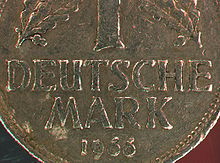 This Deutsche Mark coin shows blemishes and rim dents that would detract from its grade in appraisal.
This Deutsche Mark coin shows blemishes and rim dents that would detract from its grade in appraisal.
- Mint State (MS) 60–70: Uncirculated (UNC)
- About/Almost Uncirculated (AU) 50, 53, 55, 58
- Extremely Fine (XF or EF) 40, 45
- Very Fine (VF) 20, 25, 30, 35
- Fine (F) 12, 15
- Very Good (VG) 8, 10
- Good (G) 4, 6
- About Good (AG) 3
- Fair (FA, FR) 2
- Poor (PR, PO) 1
While the Sheldon Scale is universally acknowledged, coin experts in Europe and elsewhere often shun the numerical system, preferring to rate specimens on a purely descriptive, or adjectival, scale. Nevertheless, most grading systems use similar terminology and values and remain mutually intelligible.[33][34][35]
When evaluating a coin, the following—often subjective—factors may be considered: 1) "eye appeal" or the aesthetic interest of the coin; 2) dents on the rim; 3) unsightly scratches or other blemishes on the surface of the coin; 4) luster; 5) toning; 6) level of detail retained, where a coin with full details obviously is valued higher than one with worn details. If the coin is judged favorably in all of these criteria, it will generally be awarded a higher grade.[30]
Damage of any sort (e.g., holes, edge dents, repairs, cleaning, re-engraving or gouges) can substantially reduce the value of a coin. Specimens are occasionally cleaned or polished in an attempt to pass them off as higher grades or as uncirculated strikes. Because of the substantially lower prices for cleaned or damaged coins, some enthusiasts specialize in their collection.[36]
Coin grading services
Coin grading services are a relatively recent phenomenon, having emerged in the 1980s as a response to the need for buyers and sellers to agree on common measures of a coin's value.[37] Official grading is an effort to bring more confidence to investors in rare coins. Grading services certify the authenticity and rate the quality of individual coins, thus—it is hoped—establishing the worth of the coin relative to all others of its kind. Many coin grading services will also seal coins in a labeled, air-tight plastic holder, ensuring the coin is protected from deterioration. This process is commonly known as coin slabbing and is most prevalent in the US market.[38][39]
While professional grading has reduced the number of counterfeits foisted upon investors and has improved buyer confidence substantially, the goal of creating a sight-unseen market for coins remains somewhat elusive. Professional grading services remain the subject of controversy because grading is ultimately subjective; coins may receive different grades by different services or even upon resubmission to the same service. Due to potentially large differences in value over slight differences in a coin's condition, some commercial coin dealers will repeatedly resubmit a coin to a grading service in the hope of a higher grade.[40] Furthermore, grading services are not free, and by using them collectors funnel money into an ancillary aspect of the hobby, instead of purchasing additional material for their collections.
The two most prominent grading services at present are the Numismatic Guaranty Corporation (NGC) and the Professional Coin Grading Service (PCGS).[39] The least reputable coin dealers have a growing tendency to sell higher graded coins via sales pitches claiming that grading removes subjectivity as to the value of mint state coins. Dealers that sponsor infomercials on shortwave radio are notorious for such sales pitches, most notably Discount Gold & Silver Trading on WWCR.
See also
- Coins
- Coin catalog
- Exonumia
- Numismatics
- Challenge coin
- Regular issue coinage
- Coin grading
- List of most expensive coins
- Seigniorage
Examples
- Byron Reed Collection
- Collection at Ibn Sina Academy
References
- ^ "The Origins of Coinage:The earliest coin hoard". The British Museum:Explore/Money, www.britishmuseum.org. http://www.britishmuseum.org/explore/themes/money/the_origins_of_coinage.aspx. Retrieved 26 August 2009.
- ^ www.britannica.com. Retrieved 14 December 2010. Quote: "The Nestorian scholars and artisans who served the princes of the Jazira (Mesopotamia, now Iraq, Syria, and Turkey) in the 12th and 13th centuries designed a magnificent series of coins with motifs based on ancient Greek and Roman issues. Some of these so accurately render the details of the originals that even the inscriptions are faithfully repeated. Others were modified in intriguing ways. [...] The great variety and the sophisticated use of these images reveal the existence of well-studied collections."
- ^ a b "Coin Collecting". Britannica Online, www.britannica.com. http://www.britannica.com/EBchecked/topic/124774/coin-collecting. Retrieved 26 August 2009.
- ^ Tranquillus, C. Suetonius, The Lives of the Twelve Caesars, (1 CE) Section LXXV, http://www.gutenberg.org/files/6387/6387.txt Retrieved 23 August 2009
- ^ a b "The Coin Collection History". www.coincollectingalbum.com. http://www.coincollectingalbum.com/coin-collecting-history.html. Retrieved 26 August 2009.
- ^ "Brief History of Coin Collecting". www.2-clicks-coins.com. http://www.2-clicks-coins.com/article/coin-collecting-history.html. Retrieved 26 August 2009.
- ^ "Coin Collectors: Emperor Maximilian". www.zoomcoin.com. http://www.zoomcoin.com/rare-coin-article/coin-collectors-emperor-maximilian/. Retrieved 26 August 2009.
- ^ "Coin Collecting". BBC:H2G2, www.bbc.co.uk/dna/h2g2. http://www.bbc.co.uk/dna/h2g2/A672013. Retrieved 26 August 2009.
- ^ "Brief History of Coin Collecting". www.2-clicks-coins.com. http://www.2-clicks-coins.com/article/coin-collecting-history.html. Retrieved 26 August 2009.
- ^ a b "Collecting And Investing In Coins". www.oldandsold.com. http://www.oldandsold.com/articles02/coincollecting15.shtml. Retrieved 26 August 2009.
- ^ a b "Coin Hoards". www.australian-threepence.com. http://www.australian-threepence.com/blog/2009/07/coin-hoards.html. Retrieved 26 August 2009.
- ^ a b "What is a Coin Collector?". www.2-clicks-coins.com. http://www.2-clicks-coins.com/article/what-is-a-coin-collector.html. Retrieved 26 August 2009.
- ^ Lester, Carl N.. "Numismatic "Gumshoe:" On the Trail of King Farouk". www.goldrushgallery.com. http://www.goldrushgallery.com/news/gumshoe.html. Retrieved 26 August 2009.
- ^ Cockington, James (2009-03-11). "Tokens of our affection". The Sydney Morning Herald: p. Money supplement (p. 13). http://www.smh.com.au/news/business/money/planning/tokens-of-our-affection/2009/03/09/1236447130062.html. Retrieved 2009-03-11.
- ^ "PCGS Set Registry". www.pcgs.com. http://www.pcgs.com/setregistry/. Retrieved 26 August 2009.
- ^ "NGC Collectors Society". www.ngccoin.com. http://coins.www.collectors-society.com/registry/coins/public_sets.aspx. Retrieved 26 August 2009.
- ^ "Coin Collecting Themes-One From Every Country". www.australian-threepence.com. http://www.australian-threepence.com/blog/2009/01/coin-collecting-themes-one-from-every-country.html. Retrieved 26 August 2009.
- ^ Eggleston, Gary. "7 Popular Coin Collecting Themes". www.bellaonline.com. http://www.bellaonline.com/articles/art55473.asp. Retrieved 26 August 2009.
- ^ a b "Coin Collecting Themes". http://coinandstampcollecting.articlehq.net. http://coinandstampcollecting.articlehq.net/Coin-Collecting-Themes.html. Retrieved 26 August 2009.
- ^ a b c "Coin Collecting: Common Coin Collecting Themes". www.coincollecting101.com. http://www.coincollecting101.com/coin-collecting/coin-collecting-2/8. Retrieved 26 August 2009.
- ^ Eggleston, Gary. "7 Popular Coin Collecting Themes". www.bellaonline.com. http://www.bellaonline.com/articles/art55473.asp. Retrieved 26 August 2009.
- ^ a b Goldsborough, Reid (2008). "Counterfeit Coin Detection". http://rg.ancients.info/guide/counterfeits.html. Retrieved 26 August 2009.
- ^ "Governors". Reserve Bank of India: India's Central Bank, www.rbi.org.in. http://www.rbi.org.in/scripts/governors.aspx. Retrieved 15 November 2010.
- ^ Hardelt, Claus; Barbara Hardelt. "Fälschungen / Pseudomünzen [Falsifications/Pseudo-coins]" (in German). www.muenzen-hardelt.de. http://www.muenzen-hardelt.de/faelschung/ausland.html. Retrieved 26 August 2009.
- ^ "20 Lire dorato del Duce Benito Mussolini [Gold 20 Lira Coin of Duce Benito Mussolini]" (in Italian). www.guide.supereva.it. 2009-07-22. http://guide.supereva.it/collezionismo/interventi/2009/07/20-lire-dorato-del-duce-benito-mussolini. Retrieved 26 August 2009.
- ^ "Fakes and forgeries". The British Museum:Explore/Money, www.britishmuseum.org. http://www.britishmuseum.org/explore/themes/money/fakes_and_forgeries.aspx. Retrieved 26 August 2009.
- ^ Marotta, Michael. "Genuine Counterfeit Ancients: Plated Coins in Greek and Roman Times" (PDF). www.coin-newbies.com/articles/. http://www.coin-newbies.com/articles/genuine_counterfeits.pdf. Retrieved 26 August 2009.
- ^ "Counterfeits & Forgeries". www.parthia.com. http://www.parthia.com/parthia_forgery.htm. Retrieved 26 August 2009.
- ^ "Welcome to the Great American Coin Company". www.greatamericancoincompany.com. http://www.greatamericancoincompany.com/. Retrieved 26 August 2009.
- ^ a b "History of Grading". www.slatercoins.com. Slater Numismatics, LLC. 2008. http://www.slatercoins.com/main/page_grading_history.html. Retrieved 26 August 2009.
- ^ Mitch Hight. "Grading U.S. Coins". www.coin-gallery.com. http://www.coin-gallery.com/cggradingart.htm. Retrieved 26 August 2009.
- ^ "Grading". NGC Grading, www.ngccoin.com. http://www.ngccoin.com/coingrading/grading2.asp. Retrieved 2008-07-17.
- ^ Herbert, Alan (September 20, 1999). "European Collectors Stick With Verbal Grading System". Professional Coin Grading Service, www.pcgs.com. http://www.pcgs.com/articles/article_view.chtml?artid=1470&universeid=105&type=1. Retrieved 26 August 2009.
- ^ Guth, Ron (2009). "German Coin Grading". www.germancoins.com. http://www.germancoins.com/grading.html. Retrieved 26 August 2009.
- ^ "Grading Standards". www.fleur-de-coin.com. http://www.fleur-de-coin.com/articles/grade_standards.html. Retrieved 26 August 2009.
- ^ Eggleston, Gary. "Can Damaged Coins Find A Home?". www.bellaonline.com. http://www.bellaonline.com/articles/art52620.asp. Retrieved 26 August 2009.
- ^ "Coin Grading Systems - The History of Coin Grading Scales". About.com. http://coins.about.com/od/coingrading/a/grading_systems.htm. Retrieved 13 December 2009.
- ^ "The History of Rare Coin Grading". Austin Gold Information Network. http://goldinfo.net/morabgrad1.html. Retrieved 26 August 2009.
- ^ a b "Coin Grading Services: Who They Are and What They Do". www.coin-collecting-guide-for-beginners.com. http://www.coin-collecting-guide-for-beginners.com/coin-grading-services.html. Retrieved 26 August 2009.
- ^ "A Companion to Rare Coin Collecting - Grading Services". www.mycoincollecting.com. http://www.mycoincollecting.com/rare-coins/companion-rare-coin-collecting-Part4.html. Retrieved 26 August 2009.
Categories:
Wikimedia Foundation. 2010.

